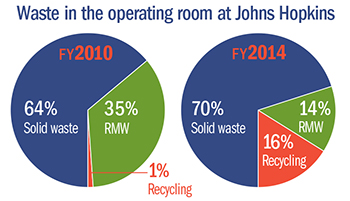 |
|
SOURCE: JOHN HOPKINS MEDICINE The charts show the significant reduction in regulated medical waste at Johns Hopkins Hospital since starting a recycling program for its OR. |
Johns Hopkins finds physician support is key to recycling If anyone could convince physicians about the merits of launching an initiative to recycle and reduce waste in the operating room, it's Lauren C. Berkow, M.D.
As a physician as well as an associate professor and director of supplies and equipment, division of neuroanesthesia, at Johns Hopkins Hospital in Baltimore, Berkow can walk the talk as both a doctor and sustainability advocate.
In addition to her teaching and clinical duties, she is a member of the American Society of Anesthesiologists (ASA) Task Force on Environmental Sustainability and serves as a physician representative on the Johns Hopkins Health System's Sustainability Leadership Council. She also is the ASA's Greening the OR liaison to Practice Greenhealth, Reston, Va.
So, when Johns Hopkins leaders decided a few years ago to get serious about sustainability on a systemwide level, including the OR, Berkow knew success depended on getting the support of surgeons and other physicians at Johns Hopkins Hospital.
Like most hospitals, Hopkins Hospital's OR previously generated an abundance of waste, Berkow told an audience at the recent Greening the OR Symposium near Chicago. Its OR produced up to 30 percent of all hospital waste and was the largest producer of regulated medical waste (RMW). Also, 50 percent of the waste at the hospital was disposed as RMW, she says.
"OR physicians are the key providers who need to be engaged to get these projects sustained and pushed forward," Berkow says. "But many were not aware of the hospital's sustainability efforts — they were focused on patient care."
That changed with an educational effort that focused on the financial and environmental benefits of recycling.
The other key was to simplify recycling by increasing the number of bins for solid waste and making RMW bins less visible to reduce the possibility of putting regular trash in the wrong bins, she says. Signage to encourage recycling helped, too.
In addition, several other waste-reduction efforts were developed, including reprocessing surgical devices, using low-flow anesthesia and reducing paper use. Key results include:
- Reducing RMW from 35 percent from mid-2010 to less than 14 percent in mid-2014 by placing it in the right containers.
- Increasing recycling of all OR waste from less than 1 percent in mid-2010 to nearly 16.5 percent by mid-2014.
- Saving nearly $5.5 million between 2010 and 2013 through an OR device reprocessing program.
- Saving more than $2.5 million through a print management program that was started in 2012.





